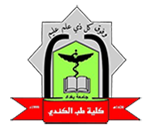History and Profile
Department of anatomy is a basic science department. We teach the first, second- and third-year students the major anatomical disciplines of gross anatomy, microscopical anatomy (histology and cytology), developmental anatomy (embryology) and gross anatomy. In gross anatomy for the first year, we teach the human body by dividing it into regions, whereas for second- and third-year gross anatomy, microscopic and developmental anatomy are taught as systems. Functional and clinical correlates are presented for each region or system, as well. All material is presented as sessions, which are divided into lecture and laboratory components, yet with the new curriculum seminars & tutorials were adds, with enhancing small group teaching as one of the forms of student centered approach all of these formats provide an opportunity to introduce the student to the various diagnostic imaging modalities and the anatomy that each may demonstrate
Vision
To ensure that the students of medicine get the required fundamental information in anatomy, in all its disciplines, at both the macroscopic and microscopic levels as well as development of the human that will integrate with his/her clinical practice to achieve the maximum medical competency.
Mission
Our mission is to educate our student to be able to describe the primary functions of anatomical structures, the relationship between anatomical structures integrate structure identification with anatomical relationships and clinical significance.
Objectives
At the end of the three-year course, the student should be able to:
- Demonstrate knowledge of normal human structure and development.
- Be able to diagnose the organs and tissues at the macro and microscopic levels.
- Describe the major organ systems, their components and the relationships between them in the normal individual.
- Recognize common variations in structure and location of organs within the body.
- Describe important anatomical landmarks on the body surface and relate them to underlying soft tissue anatomical structures as they relate to the physical examination of the patient.
- Identify anatomical structures on standard radiographic images, computed tomograms, magnetic resonance images and ultrasound studies.
Future Vision
Achieve excellence locally and regionally in the field of anatomy as (anatomy, histology, and embryology) through progression in scientific teaching, innovative research and medical education to meet the needs of the society.
| Name | Academic Degree | CV | Specialty | Title |
|---|---|---|---|---|
| Saad Ali Rashid Mohammed Al-Shammari | Iraqi Board | CV | General Surgery | Assistant Professor |
| Laith Thamer Khazal Zubaila Al-Amiri | Iraqi Board | CV | Neurosurgery | Assistant Professor |
| Shatha Salah Asaad Taha Al-Aani | PhD | CV | Life Sciences / Animal | Lecturer |
| Safa Salman Mazban Fanjan Al-Thammari | PhD | CV | Life Sciences / Cell | Lecturer |
| Mohammed Emad Ghanem Qasim Al-Shakree | PhD | CV | Anatomy, Tissue and Embryology | Lecturer |
| Houra Shafik Attiya | Master's degree | CV | Science / Applied Embryology | Assistant Lecturer |
| Shahrazad Yahya | PhD | CV | Anatomy, Tissue and Embryology | Lecturer |
| Abdulla Mohammed Baheej | PhD | CV | Anatomy, Tissue and Embryology | Lecturer |

